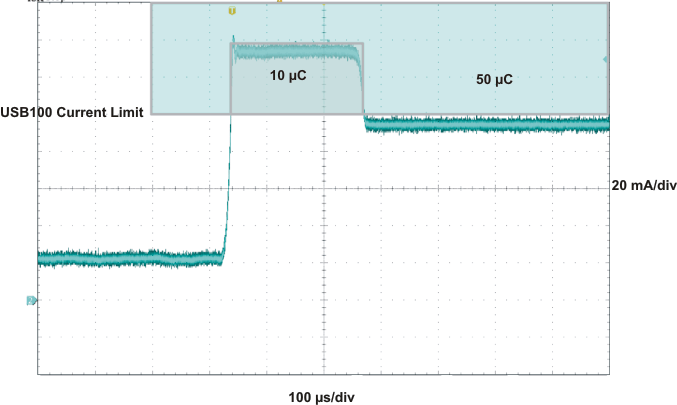ZHCSKH8C December 2009 – December 2019 BQ24072T , BQ24075T , BQ24079T
PRODUCTION DATA.
- 1 特性
- 2 应用
- 3 说明
- 4 修订历史记录
- 5 说明 (续)
- 6 Device Options
- 7 Pin Configuration and Functions
- 8 Specifications
-
9 Detailed Description
- 9.1 Overview
- 9.2 Functional Block Diagram
- 9.3
Feature Description
- 9.3.1 Undervoltage Lockout (UVLO)
- 9.3.2 Overvoltage Protection (OVP)
- 9.3.3 Dynamic Power-Path Management
- 9.3.4 Battery Charging
- 9.3.5 Charge Current Translator
- 9.3.6 Battery Detection and Recharge
- 9.3.7 Termination Disable (TD Input, BQ24072T)
- 9.3.8 Battery Disconnect (SYSOFF Input)
- 9.3.9 Dynamic Charge Timers (TMR Input)
- 9.3.10 Status Indicators (PGOOD, CHG)
- 9.3.11 Thermal Regulation and Thermal Shutdown
- 9.3.12 Battery Pack Temperature Monitoring
- 9.4 Device Functional Modes
-
10Applications and Implementation
- 10.1 Application Information
- 10.2
Typical Applications
- 10.2.1
Using the BQ24075T, BQ24079T to Disconnect the Battery from the System
- 10.2.1.1 Design Requirements
- 10.2.1.2
Detailed Design Procedure
- 10.2.1.2.1 Program the Fast Charge Current (ISET):
- 10.2.1.2.2 Program the Input Current Limit (ILIM):
- 10.2.1.2.3 Program 6.25-hour Fast-Charge Safety Timer (TMR):
- 10.2.1.2.4 TS Function:
- 10.2.1.2.5 CHG and PGOOD LED Status:
- 10.2.1.2.6 Processor Monitoring Status:
- 10.2.1.2.7 System ON/OFF (SYSOFF):
- 10.2.1.2.8 Selecting IN, OUT and BAT Capacitors
- 10.2.1.3 Application Curves
- 10.2.2 BQ24072T in a Host Controlled Charger Application
- 10.2.1
Using the BQ24075T, BQ24079T to Disconnect the Battery from the System
- 11Power Supply Recommendations
- 12Layout
- 13器件和文档支持
- 14机械、封装和可订购信息
9.4.1 Input Source Connected (Adapter or USB)
With a source connected, the dynamic power-path management (DPPM) circuitry of the BQ2407xT monitors the input current continuously. The OUT output for the BQ24075T and BQ24079T is regulated to a fixed voltage (VO(REG)). For the BQ24072T, OUT is regulated to 225 mV above the voltage at BAT. If the BAT voltage is less than 3.2 V, OUT is clamped to 3.4 V. This allows for proper startup of the system load even with a discharged battery. The current into IN is shared between charging the battery and powering the system load at OUT. The BQ2407xT has internal selectable current limits of 100 mA (USB100) and 500 mA (USB500) for charging from USB ports, as well as a resistor-programmable input current limit.
The BQ2407xT is USB IF compliant for the inrush current testing. The USB spec allows up to 10 μF to be hard started, which establishes 50μC as the maximum inrush charge value when exceeding 100 mA. The input current limit for the BQ2407xT prevents the input current from exceeding this limit, even with system capacitances greater than 10 μF. Note that the input capacitance to the device must be selected small enough to prevent a violation (<10 μF), as this current is not limited. Figure 19 demonstrates the startup of the BQ2407xT and compares it to the USB-IF specification.
 Figure 19. USB-IF Inrush Current Test
Figure 19. USB-IF Inrush Current Test The input current limit selection is controlled by the state of the EN1 and EN2 pins as shown in Table 1. When using the resistor-programmable current limit, the input current limit is set by the value of the resistor connected from the ILIM pin to VSS, and is given by the equation:
The input current limit is adjustable up to 1.5 A. The valid resistor range is 1.07 kΩ to 7.5 kΩ.
When the IN source is connected, priority is given to the system load. The DPPM and Battery Supplement modes are used to maintain the system load. Figure 21 illustrates an example of the DPPM and supplement modes. These modes are explained in detail in the following sections.